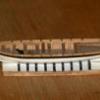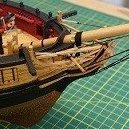Supplies of the Ship Modeler's Handbook are running out. Get your copy NOW before they are gone! Click on photo to order.
×
-
Posts
979 -
Joined
-
Last visited
Reputation Activity
-
 jwvolz got a reaction from pontiachedmark in Victory's cannons wheels
jwvolz got a reaction from pontiachedmark in Victory's cannons wheels
Every photo I have from onboard Victory shows natural wood, though certainly varnished to prevent rot.
It really makes sense when you think about it. It had to move and you probably didn't want paint preventing it from turning properly with paint getting in the joint with the axle.
-
 jwvolz reacted to David Lester in Charles W. Morgan by David Lester - Model Shipways - 1/64th scale - FINISHED
jwvolz reacted to David Lester in Charles W. Morgan by David Lester - Model Shipways - 1/64th scale - FINISHED
Good Morning,
I've spent the last little while working on the tryworks and it's now finished. I used the method described by Gerald Spargo and which is available in the resources section on the NRG main site.
It was a pretty straightforward endeavour. The only really difficult aspect is once you get to the top, it appears as though there will not be enough room for the pots, chimneys, trim etc. So it takes a bit of tweaking to get it all to fit. It's also a bit tricky to keep the walls plumb.
Gerald advised strongly to use emamel paint for the bricks and not acrylic. (Perhaps it's difficult to wipe the joint filler off acrylic paint cleanly, I'm not sure.) So I used some Humbrol flat enamel. I understand that the top surface and chimneys are copper that has blackened over time. So I painted them with Humbrol copper enamel and then dry brushed flat black over top. I'm not sure how clearly it shows up in the pictures, but you can just see bits of copper showing through. I did the same thing for the cooling tank.
So that's it for now. Many thanks for looking in.
David
-
 jwvolz reacted to captain_hook in Armed Virginia Sloop By captain_hook - FINISHED - Model Shipways - Scale 1:48
jwvolz reacted to captain_hook in Armed Virginia Sloop By captain_hook - FINISHED - Model Shipways - Scale 1:48
Yesterday I started treenailing the deck. First I used some 2mm tape to line up the holes. Then I used a I pricker to pre-drill the holes. AND THEN I started drilling....... and more drilling ... and even more. Took me about 4 hours yesterday and another 3 hours to position and drill all the holes by hand. Hard to estimate how long it would last to completely treenail a quarter scale swan class sloop. Used a 0,6mm drill (that would be about 3 cm for a real treenail). Lucky me, no broken drills.
I will start inserting toothpricks tomorrow, because my battery is more than empty for today...... After that I have to paint some areas again.
-
 jwvolz reacted to sjanicki in CSS Virginia by sjanicki - FINISHED - BlueJacket Shipcrafters - scale 1:192 (1/16" = 1')
jwvolz reacted to sjanicki in CSS Virginia by sjanicki - FINISHED - BlueJacket Shipcrafters - scale 1:192 (1/16" = 1')
Installed cleats for the flagstaffs as well as for the cutter davits. I used brass cleats, used CA glue to mount them, and then painted the flat black.
I aslo rigged the cutters. The blocks I painted brown and glued to the cutters with CA glue and then ran the line and terminating the line at the cleats on the deck. Furthermore, I darkened the color of the deck grates a bit.
Overall it’s getting very close! Next up is a clear coat to cover the various little blemishes.
I have ave also ordered a display case that will house both the USS Monitor and CSS Virginia together which should make for a nice display.
-
 jwvolz reacted to Brucealanevans in Chaperon by Brucealanevans - FINISHED - Model Shipways - 1:48
jwvolz reacted to Brucealanevans in Chaperon by Brucealanevans - FINISHED - Model Shipways - 1:48
Added the stationaries and the supports for the bull rails on the main deck, but will hold off the bull rails till later to make adding some cargo and figures easier.
The boiler deck cabin was definitely a lot of work!
Firstly, the deck shear was a bit off, so I had to do some selective sanding of the cabin sides on the bottom. This also necessitated shortening some of the doors in the sanded area. The there were the scores of battens to add.
I found the round bends at the corners difficult. Thankfully I came across the hint of gluing some card to the inside of the areas to be bent which made the occasional fracture along the bend lines tolerable instead of a disaster. I really would call the process more of a series of controlled fractures than a bend.
After painting, added the door frames in red, glazed all the windows with clear plastic, and added pin heads to simulate door handles on each door.
I opted not to wet, dry, and sand the cabin sides prior to painting which gave them a more aged and shabby look.
Here are the cabin pieces dry fitted. Will add some gray pastel aging before gluing.
Then on to the two staircases and the hurricane deck.
I will wire the lights for the boiler deck cabin on top of the deck within the skylight structure.
-
 jwvolz reacted to RMC in Granado by RMC - FINISHED - Caldercraft - 1:64
jwvolz reacted to RMC in Granado by RMC - FINISHED - Caldercraft - 1:64
The bulkhead is finally complete - treenails and all. I can't think of anything that has given more trouble (at least in building model ships) most of which is self-inflicted. The obvious advice is to fit the curved supports before planking. The spaces provided for them in the plywood decking are far too long. As well I would advise using polystyrene for the panels. The plywood panels supplied did not want to bend to shape.
The quarterdeck is now in progress.
-
 jwvolz reacted to Chuck in Medway Longboat 1742 by Chuck - FINISHED - 1/2" scale
jwvolz reacted to Chuck in Medway Longboat 1742 by Chuck - FINISHED - 1/2" scale
Thanks guys....
Working on making a simple stand/cradle. This isnt a small model especially after its rigged so I want it to be sturdy. These will be added to the masting and rigging kit when its made available. Toying around with trying to lasercut them in plexi but as it stands now they will be cherry. I may also paint them black but wanted to see if they were less obtrusive the same color as my baseboard....not included.
Chuck
-
 jwvolz reacted to Chuck in Medway Longboat 1742 by Chuck - FINISHED - 1/2" scale
jwvolz reacted to Chuck in Medway Longboat 1742 by Chuck - FINISHED - 1/2" scale
The photo below shows the thole pins on the contemporary model. There is a discrepancy between this model and the other contemporary model. This one has an extra row or two more pairs of thole pins than the other model. I opted to go with fewer. I made my thole pins from boxwood but you guys can easily replace with wire if you wanted. I took a 3/64" x 3/64" strip and rounded it off in my Dremel. I dont like the way the wire takes paint and because of this large scale I opted for wood instead, but this means you must also round off your stock in a Dremel as well. If that is too much of a hassle though then wire can be used in its place....probably 16 gauge or 18 gauge.
I drilled holes along the cap rail with a #55 drill bit and glued them in place. Then they were painted red. But you could leave them natural too....if you use the boxwood that comes with the kit.
THIS COMPLETES THE HULL!!! Except for the oars but I will do that after I rig it......So let the masting and rigging begin.
-
 jwvolz reacted to MESSIS in Sir Winston Churchill by Messis - FINISHED - Woody Joe - 1/75
jwvolz reacted to MESSIS in Sir Winston Churchill by Messis - FINISHED - Woody Joe - 1/75
Just fitting parts....
-
 jwvolz reacted to Beef Wellington in HMS Jason by Beef Wellington - Caldercraft - 1:64 - Artois-class frigate modified from HMS Diana 1794
jwvolz reacted to Beef Wellington in HMS Jason by Beef Wellington - Caldercraft - 1:64 - Artois-class frigate modified from HMS Diana 1794
Happy Thanksgiving to all of those in the US! Unfortunately the shipyard has had to suddenly close due to a minor, but messy, health and safety violation involving a clumsy thumb and Xacto knife - nothing serious but plasters/band-aids preventing fine work.
Good opportunity to sit back and ponder gun rigging as I'll need to order additional materials from Syren. Think I'm done with additional detailing on the cannons in the interests of sanity;
Monograms are from Syren, given a quick dash of 'dark iron' Cpaint and glued into place with CA Cap-square eyebolt made with wire and the cap square joint bolt is one of the smaller PE ring bolts.
First mock up of potential rigging, as previously discussed, the breech rope is 0.88mm Syren line. This line does make the half hitch a little more cumbersome, but think it can still work, even though they will be somewhat hidden even for most visible guns in the waist. Going to live without the wheel lynch pin and cap square pin/chain.
Cannon rigging:
Breeching rope does require some dilute PVA to hold into position on the button. Wanted to give the hauling tackle a feeling of 'weight', and have been experimenting assembling these off the model using a serving machine to get consistent spacing and also do the frapping. Procedure still to be finalised…
Details as follows:
Block are 1/8" (3.18mm) single/double blocks from Syren Blocks are stropped with 0.012"(0.3mm) line Port tackle line is 0.008" (0.2mm) line Hooks are 4mm from Syren (these are black plastic which I ordered some time ago and don't think Chuck still offers them which is a shame as they seem easy to work with)
-
 jwvolz reacted to sjanicki in CSS Virginia by sjanicki - FINISHED - BlueJacket Shipcrafters - scale 1:192 (1/16" = 1')
jwvolz reacted to sjanicki in CSS Virginia by sjanicki - FINISHED - BlueJacket Shipcrafters - scale 1:192 (1/16" = 1')
I took @MrBlueJacket‘s advice about using CA glue to attach the covers for the cutters to great success. Up next is installing some cleats for the flag staffs and cutter davits. Getting close!
-
 jwvolz got a reaction from jim_smits in HMS Snake by jim_smits - Caldercraft - First Build
jwvolz got a reaction from jim_smits in HMS Snake by jim_smits - Caldercraft - First Build
Looking good Jim.
-
 jwvolz got a reaction from Old Collingwood in HMS Snake by jim_smits - Caldercraft - First Build
jwvolz got a reaction from Old Collingwood in HMS Snake by jim_smits - Caldercraft - First Build
Looking good Jim.
-
 jwvolz reacted to jim_smits in HMS Snake by jim_smits - Caldercraft - First Build
jwvolz reacted to jim_smits in HMS Snake by jim_smits - Caldercraft - First Build
Here you go master cog! 😉
Foreyard is attached and the main slings and trusses are in place as previously mentioned.
The positioning of the yard will be tweaked when the braces etc are rigged in.
Next steps now are to make the top and topgallant yards.
-
 jwvolz reacted to svein erik in US Brig Syren by svein erik - Model Shipways - 1:64 - 18 gun brig
jwvolz reacted to svein erik in US Brig Syren by svein erik - Model Shipways - 1:64 - 18 gun brig
Thanks everyone,
Here is the finish result of the cradle ☺now I can move farword with the dekk fittings etc!
-
 jwvolz reacted to David Lester in Charles W. Morgan by David Lester - Model Shipways - 1/64th scale - FINISHED
jwvolz reacted to David Lester in Charles W. Morgan by David Lester - Model Shipways - 1/64th scale - FINISHED
Good Morning,
I have a bit of progress to report. I've finished up quite a few details on the hull including the coppering as well as a couple of more pieces of the deck details. (All are just sitting on the deck for the photos - none is actually installed yet.)
There are a number of portholes etc that are not included in the kit, so I ordered a few different ones. It took a bit of research finding the right sizes but in the end I found some nice small ones - only 1.2mm - for the smallest openings and a couple of different bigger sizes for the others.
The oblong mooring chocks are a bit of a mystery to me. The plans indicate four of them on the starboard side and none on the port size, but the kit comes with six. So that's more than needed for the outboard side of the openings, but not enough for both the outboard and inboard sides of the openings. So I used the four kit supplied ones on the outboard side and then used new brass portholes which I bent into an oblong shape for the inboard side and it seems to work well enough. You can see them clearly below.
Stern details finished -
I always find finishing the decking to be a challenge. The basswood takes the stain so poorly that it's hard to get a nice consistent finish. I also like to try to simulate the grayed out look that decks usually have on the real ship. I'm fairly happy with the result I got this time, but don't ask me to duplicate it! It was a lengthy series of experimental steps. This time I used acrylic artists' paint.I started with a thinned mixture of black, white, dark brown and yellow, mixed to achieve a sort of taupe colour. I brushed it on and rubbed it down. Then there was miserable series of steps - adding more brown because it was too gray; adding more black because it was too brown; adding more white because it was too dark; adding more yellow because - well because it was the only colour left to add and then going through the whole process over and over again. When I was finally reasonably happy, I rubbed the whole thing down with steel wool which resulted in a very nice finish and a colour that I think looks ok.
(Also, while I'm on the topic of decking - this kit has no sub-decking. The decking planks are 1/16" thick and install directly on the bulkheads. If I was doing it again, I would buy 1/32" sheets and make a sub-deck and then install 1/32" planks over that. It would be much easier to get a good even surface and there would be no concerns about plank butts not lining up with the bulkheads.)
The bigger challenge though, was getting a crisp line along the top edge of the upper white stripe. This is the outboard edge of the top rail and according to the pictures I've seen, the white should only be on the vertical surface, not the horizontal surface. After many failed attempts at painting, I realized I would never get a good clean line where the white and black meet. The upper edge of that white line is highly visible and the least deviation jumped out at me.
I considered using a styrene strip which would give a good sharp line. I'm not opposed to using styrene in principal, but in this case it was just too front and centre so I abandoned that idea. In the end, I painted a piece of paper and applied that. I have some really nice black paper that I used to simulate small iron fittings etc. It's not as heavy as card stock, but heavier than regular paper. It painted beautifully, without any wrinkling. I cut narrow strips of it and glued it on and it solved the problem!
The pump handles are another kit mystery. They provide a small centre fitting, but then you are supposed to attached extended handles to it. I couldn't see any way to do that easily or nicely, so I discarded it and fabricated the whole part as one from brass -
So that's where I'm at so far. Next up is the tryworks, which looks like it will present some fresh challenges too.
This is one of the most enjoyable builds I have done yet, and if anyone is considering this kit, I would definitely recommend it.
Again, many thanks for comments and likes.
David
-
 jwvolz reacted to David Lester in Charles W. Morgan by David Lester - Model Shipways - 1/64th scale - FINISHED
jwvolz reacted to David Lester in Charles W. Morgan by David Lester - Model Shipways - 1/64th scale - FINISHED
Good Morning,
I've been working away at this and that. I spent a lot of time yesterday (raining all day, couldn't rake leaves) working on the lettering for the stern. I don't know what the decorative "f" in the centre is property called; whether it's simply a decoration or some old-fashioned contraction for "of". In any case it presented a bit of a challenge to duplicate. There is an elaborate "f" in the special characters section of Word, but it wasn't quite right. In the end I downloaded this image from Google:
Then I doctored it with Photoshop and the result isn't too bad:
The next photo shows my lettering above the lettering on the actual ship:
And finally, on my model:
I also finished the skylight:
Using sewing thread for the rods worked quite well. Because it's so fine, I was able to get the same number of them in place as on the ship. For the bottom portion, I had stiffened the thread with CA glue, but for the upper portion, I tried it without adding the CA glue and it actually worked a little better.
I am now working on a number of small details to the hull - portholes, etc before turning the hull upside down and staring on the copper plating.
Again, thanks for likes and comments.
David
-
 jwvolz got a reaction from davyboy in HMS Cruiser by Thunder - FINISHED - Caldercraft - 1:64 Scale
jwvolz got a reaction from davyboy in HMS Cruiser by Thunder - FINISHED - Caldercraft - 1:64 Scale
My cap rail was off at the stern as well in a similar manner. I cut it off and scratched a new one from the point where it diverged from the hull.
-
 jwvolz got a reaction from Beef Wellington in HMS Jason by Beef Wellington - Caldercraft - 1:64 - Artois-class frigate modified from HMS Diana 1794
jwvolz got a reaction from Beef Wellington in HMS Jason by Beef Wellington - Caldercraft - 1:64 - Artois-class frigate modified from HMS Diana 1794
Very nice work Jason!
-
 jwvolz got a reaction from Beef Wellington in HMS Cruiser by Thunder - FINISHED - Caldercraft - 1:64 Scale
jwvolz got a reaction from Beef Wellington in HMS Cruiser by Thunder - FINISHED - Caldercraft - 1:64 Scale
Good luck with your build. I'm building the kit now and it's been quite enjoyable. I've made some modifications along the way as well to try to get a more historic rendering.
I'll be following along!
-
 jwvolz got a reaction from Peter Bloemendaal in US Brig Syren by Peter Bloemendaal - FINISHED - Model Shipways - 1:64
jwvolz got a reaction from Peter Bloemendaal in US Brig Syren by Peter Bloemendaal - FINISHED - Model Shipways - 1:64
Very nice progress, she looks great.
-
 jwvolz reacted to Peter Bloemendaal in US Brig Syren by Peter Bloemendaal - FINISHED - Model Shipways - 1:64
jwvolz reacted to Peter Bloemendaal in US Brig Syren by Peter Bloemendaal - FINISHED - Model Shipways - 1:64
Thanks for all the likes everyone.
Time for another update. I have been progressing nicely without any dramas (touch wood...lol).
I have been building up the masts up to the point where I have to add all the blocks. Next will be gluing them into the hull. That will be a milestone and definitely a task I will take my time with. I plan not to use a jig but I will likely cover a fair distance running around the model to make sure they line up while the glue sets.
I also made a start on the chain plate assemblies (so I can multitask after all, didn't think I had it in me....lol). I haven't put them on the channels yet.
There are a few photo's to get through so better get on with it....
Cheers, Peter
-
 jwvolz reacted to Peter Bloemendaal in US Brig Syren by Peter Bloemendaal - FINISHED - Model Shipways - 1:64
jwvolz reacted to Peter Bloemendaal in US Brig Syren by Peter Bloemendaal - FINISHED - Model Shipways - 1:64
Thanks for the 'likes' again everyone.
Made a start on the lower masts. They make a great change on the overall look of the ship. Still have to add a few bits and pieces to complete them but I thought it is worth sharing a few photo's.
I thinks I am in luck with how they fit in the holes on the deck. I made the tenons a bit longer and gave them a snug fit. Then I rotated the masts to a position where the tilt angle was just about right. I marked the positions and started building up the mast assemblies.
So when Gluing time comes in the distant future it doesn't look like I will need a big setup for the positioning of the masts (fingers crossed). Here a some photo's.
Cheers, Peter.
-
 jwvolz got a reaction from Old Collingwood in HMS Jason by Beef Wellington - Caldercraft - 1:64 - Artois-class frigate modified from HMS Diana 1794
jwvolz got a reaction from Old Collingwood in HMS Jason by Beef Wellington - Caldercraft - 1:64 - Artois-class frigate modified from HMS Diana 1794
Very nice work Jason!
-
 jwvolz reacted to EdT in Young America 1853 by EdT - FINISHED - extreme clipper
jwvolz reacted to EdT in Young America 1853 by EdT - FINISHED - extreme clipper
Young America - extreme clipper 1853
Part 306 – Fore Topgallant Yard 2
While the spanker rigging was going on, I also worked on rigging the fore topgallant yard. In the first picture most of the ironwork has been fitted as well as the fore royal sheet chains.
At this scale these chains are well under the size of any available chain by a factor of more than 2. As with other small chains shown earlier, these were made by twisting a doubled loop of wire by approximately the correct number of turns for its length – assuming one turn per 2 links - an imprecise process for sure. The next picture shows a closer view of the chain and the sheet block under the center of the yard.
After erecting the yard and completing its rigging, I decided to replace this chain with a slightly heavier version. I will show it in a later post.
In the next picture, the yard's halyard - a somewhat larger twisted wire chain - has been passed through the topgallant mast sheave with a pin inserted to hold it in place.
The chain may be seen just behind the mast in this picture. The position held by the temporary pin is set to suspend the yard just above the topmast cap. The chain halyard runs down behind the mast to a tackle shown in the next picture.
The tackle is long enough to allow the yard to be hauled up to its full height. In the next picture, the yard with all its bench-installed rigging has been mounted on the mast.
The halyard, slanting out due to its stiffness (see arrow), has not yet been connected at the sling band. Bunt and leech lines were routed down the mast before erecting the yard and may be seen draped from their double blocks above. The wire chain sheets are doing their own thing. Twisted wire behaves exactly opposite actual chain, which drapes beautifully in graceful curves. Wire chain has to be carefully shaped to do so. This will be done later after the loose ends are connected to the royal clue lines.
In the next picture, the halyard chain has been connected to the sling band, the bunt and leech lines are rigged and the clew lines are connected to the chain sheets below.
The royal sheet chains described above, were the first to be connected after the halyard, so that these could be used to pull down the yard. The next picture shows the halyard and its eyebolt as well as the two chain sheets hauled down below the sheet block.
The thin chain sheets (later replaced) may be seen in front of the mast in this picture. Each leg is connected to a rope line that runs down to belay on the main rail, port and starboard. The bunt, leech, and clew lines run down inside the shrouds, through shroud fairleads and belay on those rails as well. The next picture shows these lines running through the top fairleads.
All these fairlead holes are starting to fill up. The arrow in the picture points to the halyard chain. The main rail pins are also filling up as shown in the next picture.
Finally, a view of the model in its present state.
Ed







